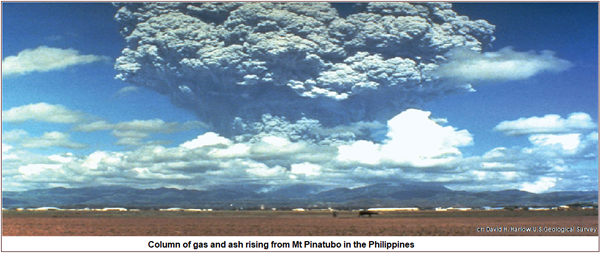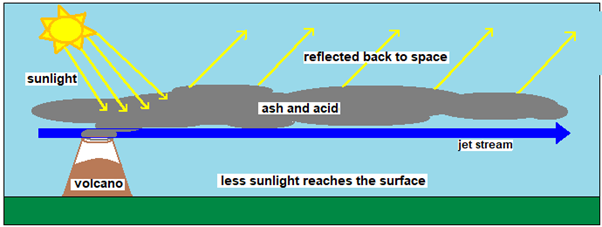
Volcanic eruptions triggered the collapse of dynasties, says S.Ananthanarayanan.
While features like mountains and rivers give shape to geopolitics, changes in the climate can be powerful influencers too. The world’s responses to the current crisis, of global warming, has created several uncertainties. There could be major changes in the global political pecking order within a few decades.
Social and cultural mores are shaped by climate, the harshness of summers or winters, for instance, or the level of rainfall. And changes in the climate lead to social responses. An instance is how the profile of rooftops in China grew sharper or shallower as the extent of snowfall varied over the seasons. Another example is the vast Iron Age empire, the neo-Assyrian, in Mesopotamia, which rose to great heights in the 3 centuries from 911 BCE to 609 BCE, a period of ample rainfall, compared to past millennia. But when mega droughts struck in the 7th century BCE, the empire declined rapidly, making way for the neo-Babylonian empire, over a short 60 years,
A group of researchers writing in the journal, Nature Communications, use state-of-the-art methods to identify severe, short term, climate effects of volcanic eruptions, over two millennia of Chinese history. And by matching the events with political history, the team of Chaochao Gao, Francis Ludlow, John A. Matthews, Alexander R. Stine, Alan Robock, Yuqing Pan, Richard Breen, Brianán Nolan and Michael Sigl, from Zhejiang University, Hangzhou, China, Trinity College Dublin, San Francisco State University, Rutgers University, Florida State University, Rachel Carson Center for Environment and Society, Munich and University of Bern, Switzerland , discover “a systematic association” between the eruptions and instances of dynastic collapse.
Enquiry into how far climatic events have influenced societal decay, the paper says, has been limited because the evidence, both of climate events and social changes, in past periods, is at best approximate. In the case of China, however, there are reliable records of the fortunes of a sizeable number of dynasties, 68, in fact, over the first 2,000 years CE. And this record, of long reigns, with numerous dynastic changes, presents an `opportunity to see if there could be correlation with changes in the climate.
Many cases of the end of a dynasty have been described as a ‘collapse’, clearly because the end was abrupt and accompanied by a military debacle, loss of lives and economic distress. But there are others, the paper says, where the process was gradual, and the reason for decline has often been stated as rising corruption and dissipation, and general mismanagement. And there are instances where climatic events, like droughts and extreme cold have been linked, and cases where volcanic eruptions could have led to the climatic change and the collapse. These, however, the paper says, are episodic and it has not been possible to find a thread that shows that volcanic activity, and resulting climatic effects, have generally gone before the downfall of a dynasty.
Volcanic eruptions, the paper says, “are one of the most important drivers of sudden and pronounced short-term climatic variability.” The particulate matter that fills the atmosphere, over a wide region above the eruption, for months, even years, on end, has two immediate effects. The particles reflect and scatter sunlight, leading to dark days and cooling. And then, the evaporation from water bodies is reduced. The cycle of moisture-laden air masses is hence disrupted and rainfall becomes scanty. And the result is that there are lower temperatures and there is drought, during the agricultural growing season. And the impact is compounded by livestock death, which gets worse with degradation of the land. And a consequence of volcano activity in the tropics is that there are mild winters. This promotes the survival of pests, which leads to further damage to crops.

Agronomy was critical to the populous Chinese dynasties. Sudden climate change and extreme weather could hence disrupt economic and political equations. There could be shortages and displacement of populations, and cascading pressures that would topple the delicate balance that sustained royalty. The “mandate from heaven”, the authority of the dynasty to rule, was called in question and the stage was set for rivals to move in, and a new order to take over.
The team of researchers scoured a great many historical sources, to establish a time-line of the dynasties that held power in China during the first two millennia CE. It was important to fix the dates accurately, the paper says, for successful linking of political events with geological records of volcanic events. Hence the need to examine several historical accounts, to reduce uncertainty which often crept in.
Volcanic activity
The record of volcanic activity through the two millennia was extracted from geological evidence. Volcanic events throw up huge quantities of ash, dust and particles, and if the events are powerful, as would be the events that affected the fortunes of dynasties, the material could travel round the globe. The material would then settle as deposits on ice surfaces in different parts of the world. And the deposits are covered by fresh snowfall, and are trapped. Ice sheets or glaciers form by incremental build-up of annual layers. Lower layers are thus older than layers closer to the surface and the ice mass is a record of deposits collected over centuries.
The way to extract the information buried in the ice is to bore into the ice using a shell, with an arrangement to bring up samples of ice from different depths. The drills can go down to over 3 km, where the samples of ice are 800,000 years old. The team relied on borings in Greenland and Antarctic ice and identified years of volcanic activity when sulphate deposits were detected. They were then able to identify and date 158 instances of major volcanic eruptions in the northern hemisphere, between the years 1 CE and 1915 CE.
Whether volcanic events were associated with dynastic collapse was then examined by plotting the frequency of volcanic events within the window from 10 years preceding to two years after an instance of dynastic collapse. This 12-year window takes into account the uncertainty in the dates of the volcanic and political events, and also the lag that there would be before there is social response to a climate event.
The result of this survey was that “one or more eruptions preceded the majority (62 out of 68) collapses.” To make sure that this apparently high association is not something arising from chance, the data was subjected to statistical analysis, taking the average frequency of eruptions observed in the ‘collapse windows’ and the probability of these eruptions occurring by chance. The analysis, the paper says, established the association with an assurance between 99 and 99.95%.
This remarkable association underscores the fragility of political equilibrium and the strong leverage that climate change can exert. The record studied is of rapid changes at a time of slower communications and mobility. In our current crisis, we have been warned since some decades and we have the capability to adapt and mitigate the threat. And the stakes, if we do not respond, are higher, not just political change, but environmental collapse as well.
------------------------------------------------------------------------------------------ Do respond to : response@simplescience.in-------------------------------------------